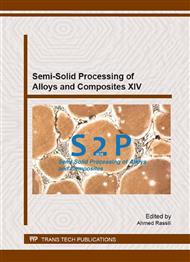[1]
C.W. Macosko, Rheology: Principles, Measurements and Applications, Wiley-VCH Publishers, New York, (1994).
Google Scholar
[2]
T. Iida, R.I.L. Guthrie, The physical properties of liquid metals, Clarendon Press, Oxford, (1988).
Google Scholar
[3]
R.P. Chhabra, J.F. Richardson, Non-Newtonian Flow in the Process Industries: Fundamentals and Engineering Applications, Butterworth Heinemann, (1999).
Google Scholar
[4]
A.T. Dinsdale, P.N. Quested, The viscosity of aluminium and its alloys - A review of data and models, J. Mat. Sci. 39 (2004) 7221-7228.
DOI: 10.1023/b:jmsc.0000048735.50256.96
Google Scholar
[5]
M.J. Assael, I.J. Armyra, J. Brillo, S.V. Stankus, J. Wu, W.A. Wakeham, Reference Data for the Density and Viscosity of Liquid Cadmium, Cobalt, Gallium, Indium, Mercury, Silicon, Thallium, and Zinc, J. Phys. Chem. Ref. Data 41, 3 (2012) 1-16.
DOI: 10.1063/1.4729873
Google Scholar
[6]
V. Varsani, Z. Fan, Non-Newtonian behaviour of liquid metals, T. Indian I. Metals 60, 2-3 (2007) 251-256.
Google Scholar
[7]
Y. Qi, T. Çain, Y. Kimura, W.A. Goddard III, Viscosities of liquid metal alloys from nonequilibrium molecular dynamics, J. Comput. Aided Mater. Des. 8 (2001) 233-243.
Google Scholar
[8]
M.M. Malik, M. Jeyakumar, M.S. Hamed, M.J. Walker, S. Shankar, Rotational rheometry of liquid metal systems: Measurement geometry selection and flow curve analysis, J. Non-Newtonian Fluid Mech. 165 (2010) 733–742.
DOI: 10.1016/j.jnnfm.2010.03.009
Google Scholar
[9]
M. Jeyakumar, M. Hamed, S. Shankar, Rheology of liquid metals and alloys, J. Non Newtonian Fluid Mech. 166 (2011) 831–838.
DOI: 10.1016/j.jnnfm.2011.04.014
Google Scholar
[10]
M.T. Johnston, R.H. Ewoldt, Precision rheometry: Surface tension effects on low-torque measurements in rotational rheometers, J. Rheol. 57, 6 (2013) 1515-1532.
DOI: 10.1122/1.4819914
Google Scholar
[11]
T. G Nguyen, D. Favier, M. Suery, Theoretical and experimental study of the isothermal mechanical behaviour of alloys in the semi-solid state, Int. J. Plasticity 10, 6 (1994) 663-693.
DOI: 10.1016/0749-6419(94)90028-0
Google Scholar
[12]
J. Koke, M. Modigell, Flow behaviour of semi-solid metal alloys, J. Non-Newtonian Fluid Mech. 112 (2003) 141-160.
DOI: 10.1016/s0377-0257(03)00080-6
Google Scholar
[13]
A. Pola, R. Roberti, M. Modigell, L. Pape. Rheological characterization of a new alloy for thixoforming. Sol. St. Phen. 141-143 (2008) 301-306.
DOI: 10.4028/www.scientific.net/ssp.141-143.301
Google Scholar
[14]
H. Bettin, H. Fehlauer, Density of mercury – measurements and reference values, Metrologia 41 (2004) 16-23.
DOI: 10.1088/0026-1394/41/2/s02
Google Scholar
[15]
M.J. Assael, A.E. Kalyva, K.D. Antoniadis, R.M. Banish, I. Egry, J. Wu, E. Kaschnitz, W.A. Wakeham, Reference Data for the Density and Viscosity of Liquid Copper and Liquid Tin, J. Phys. Chem. Ref. Data 39 (2010) 1-8.
DOI: 10.1063/1.3467496
Google Scholar


